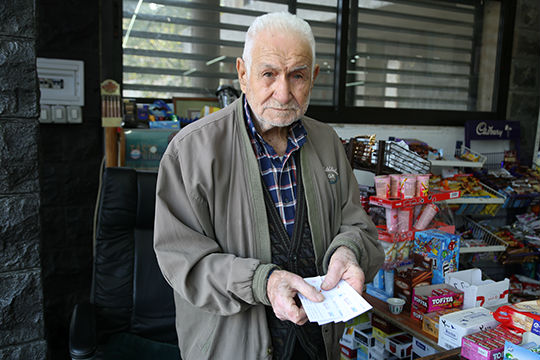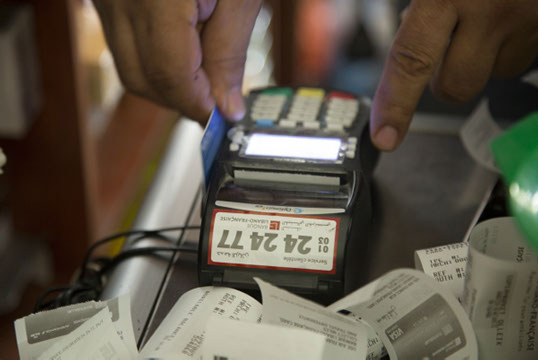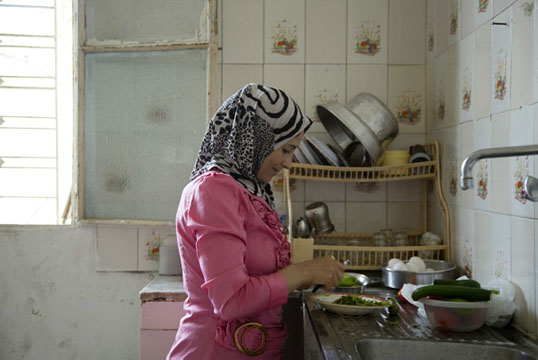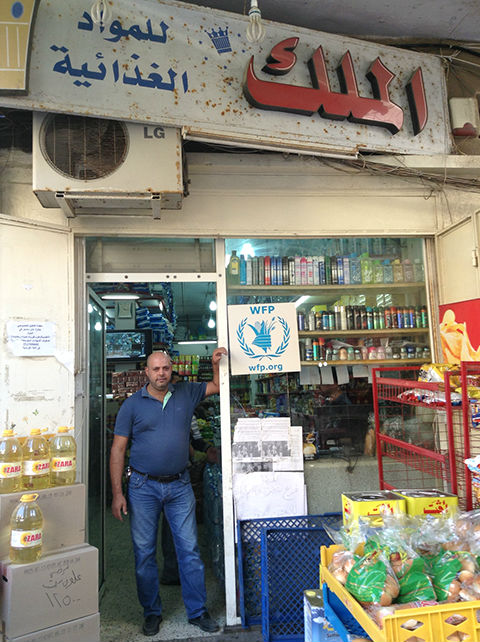WFP e-voucher programme in Lebanon
By Ekram Mustafa El-Huni
 Ekram Mustafa El-Huni is WFP’s Head of Programmes in Beirut, Lebanon. She has worked in a variety of roles with WFP at the headquarters, regional bureau and country office levels in both in regular activities and emergencies. She holds a Masters in Development Economics with an emphasis on Food Security and Human Development.
Ekram Mustafa El-Huni is WFP’s Head of Programmes in Beirut, Lebanon. She has worked in a variety of roles with WFP at the headquarters, regional bureau and country office levels in both in regular activities and emergencies. She holds a Masters in Development Economics with an emphasis on Food Security and Human Development.
The author acknowledges the work of WFP staff and partners, and the support of WFPs generous donors.
Context
WFP began delivering food assistance in June 2012, following an official request from the
Government of Lebanon in May 2012. The Lebanese High Relief Commission (HRC), UN High Commissioner for Refugees (UNHCR), local organisations and private citizens, who had been assisting Syrians up to that point, found their capacities challenged to meet the rising demand. In northern Lebanon, WFP began by taking over half of UNHCR’s caseload of some 15,000 refugees and started distributing food vouchers to 1,550 refugees in the Bekaa Valley. By May 2014, WFP’s operations had expanded dramatically, providing monthly assistance to over 744,000 Syrian refugees, mainly through the provision of food vouchers, and with one-off food parcels for newly arrived refugees. The e-voucher programme, also known as the ‘e-card’ programme, is WFP’s primary means of providing food assistance to Syrian refugees in Lebanon, accounting for over 90% of the monthly caseload. This article describes WFP’s experiences in the evolution of what is currently WFP’s largest voucher programme worldwide.
Programme implementation
 WFP began transitioning from paper food vouchers to electronic pre-paid vouchers (e-cards) in September 2013. As the caseload of refugees in Lebanon continued to increase exponentially, the printing, distribution and reconciliation of paper vouchers became a major challenge for WFP and partner staff, absorbing considerable staff time. Abandoning the voucher system was not an option as it had made a significant contribution to the Lebanese economy and the approach had proved highly suited to the urban context in a middle income country. As a result, WFP Lebanon shifted to an electronic, pre-paid voucher system. E-cards were adopted as the primary modality of assistance due to Lebanon’s inherent ability to meet an increase in consumer demand without affecting its current supply lines and price levels. This ambitious move ensured that the benefits continued to be realised by the host country, while simultaneously addressing many of the outstanding programmatic issues relating to the vouchers.
WFP began transitioning from paper food vouchers to electronic pre-paid vouchers (e-cards) in September 2013. As the caseload of refugees in Lebanon continued to increase exponentially, the printing, distribution and reconciliation of paper vouchers became a major challenge for WFP and partner staff, absorbing considerable staff time. Abandoning the voucher system was not an option as it had made a significant contribution to the Lebanese economy and the approach had proved highly suited to the urban context in a middle income country. As a result, WFP Lebanon shifted to an electronic, pre-paid voucher system. E-cards were adopted as the primary modality of assistance due to Lebanon’s inherent ability to meet an increase in consumer demand without affecting its current supply lines and price levels. This ambitious move ensured that the benefits continued to be realised by the host country, while simultaneously addressing many of the outstanding programmatic issues relating to the vouchers.
 Families in need received one e-card that is automatically uploaded with US$30 worth of credit per person each month. The e-cards can then be redeemed in any of 340 small and medium size shops spread across the country. The automatic reloading of credit means beneficiaries no longer need to attend large-scale monthly distributions1, thereby reducing their transportation costs; the number of distributions is reduced simply to those who have newly arrived. Furthermore, e-cards provide beneficiaries with greater purchasing flexibility as they can purchase by preference and need and make multiple purchases throughout the month. In addition, merchants receive their payments more promptly since shops, partners and WFP no longer need to manually collect and (re-)count the vouchers before payment. Since December 2013, the e-card modality has covered the entire country and has been implemented by some of the same extended network of cooperating non-governmental organisations (NGO) partners that conducted the paper voucher system. The cooperating partner NGOs include the Danish Refugee Council, World Vision International, Premiere Urgence-Aide, Medical Internationale, Action Contre la Faim, Save the Children, Mercy Corps and InterSoS.
Families in need received one e-card that is automatically uploaded with US$30 worth of credit per person each month. The e-cards can then be redeemed in any of 340 small and medium size shops spread across the country. The automatic reloading of credit means beneficiaries no longer need to attend large-scale monthly distributions1, thereby reducing their transportation costs; the number of distributions is reduced simply to those who have newly arrived. Furthermore, e-cards provide beneficiaries with greater purchasing flexibility as they can purchase by preference and need and make multiple purchases throughout the month. In addition, merchants receive their payments more promptly since shops, partners and WFP no longer need to manually collect and (re-)count the vouchers before payment. Since December 2013, the e-card modality has covered the entire country and has been implemented by some of the same extended network of cooperating non-governmental organisations (NGO) partners that conducted the paper voucher system. The cooperating partner NGOs include the Danish Refugee Council, World Vision International, Premiere Urgence-Aide, Medical Internationale, Action Contre la Faim, Save the Children, Mercy Corps and InterSoS.
WFP also provides monthly food parcels to vulnerable newly arrived refugees awaiting registration. These parcels, which contain mixed rations of some 19 different items (including rice, wheat, flour, canned foods, packaged cheese, sugar, tea and coffee, etc.), help to cover a family’s food needs for a period of one month. Parcels are transferred directly to WFP’s cooperating partners in the field who store and distribute the parcels each month. In addition, WFP had a contingency stock of approximately 35,000 food parcels that could be used in case of a sudden influx of refugees, such as with the Arsal influxes in November 2013 and February 2014.
Vulnerability assessment
 In May and June 2013, WFP, UNHCR and UNICEF conducted the Vulnerable Assessment of Syrian Refugees (VASyR), a multi-sectoral annual survey aimed at understanding the living conditions and vulnerability profiles of Syrian refugees in order to guide respective responses. The survey concluded that approximately 30% of households could meet their basic food and non-food needs. The remaining 70% of households were deemed to be either highly or severely vulnerable. Furthermore, the VASyR found that Syrian refugees were highly reliant on food assistance as their main food source, and thus WFP assistance remained a high priority to prevent the deterioration of refugees’ food security status. The assessment showed that nearly 30% of Syrian households surveyed relied on some type of assistance as their main livelihood source; mainly food vouchers (24%). Furthermore, food assistance deters the adoption of additional negative coping strategies, thereby freeing up cash resources to be used for other immediate needs (shelter, health, water, sanitation and hygiene, education, etc.). On average, a refugee household’s expenditure was US$774 per month; nearly half of this amount was spent on food. In addition, the survey found that the income versus expenditure gap, caused by limited livelihood opportunities, rising rent, food and services prices, induced greater use of negative coping strategies as the
In May and June 2013, WFP, UNHCR and UNICEF conducted the Vulnerable Assessment of Syrian Refugees (VASyR), a multi-sectoral annual survey aimed at understanding the living conditions and vulnerability profiles of Syrian refugees in order to guide respective responses. The survey concluded that approximately 30% of households could meet their basic food and non-food needs. The remaining 70% of households were deemed to be either highly or severely vulnerable. Furthermore, the VASyR found that Syrian refugees were highly reliant on food assistance as their main food source, and thus WFP assistance remained a high priority to prevent the deterioration of refugees’ food security status. The assessment showed that nearly 30% of Syrian households surveyed relied on some type of assistance as their main livelihood source; mainly food vouchers (24%). Furthermore, food assistance deters the adoption of additional negative coping strategies, thereby freeing up cash resources to be used for other immediate needs (shelter, health, water, sanitation and hygiene, education, etc.). On average, a refugee household’s expenditure was US$774 per month; nearly half of this amount was spent on food. In addition, the survey found that the income versus expenditure gap, caused by limited livelihood opportunities, rising rent, food and services prices, induced greater use of negative coping strategies as the
Syrian crisis becomes more protracted, increasing the financial pressure on vulnerable refugees. The assessment also showed that more and more families were taking on debt as households spent their savings and sold their remaining assets to meet their basic requirements.
Monitoring
The VASyR collects information to help understand the scale and nature of vulnerability, e.g. dietary diversity, coping strategies, which can then be used to re-evaluate targeting criteria. WFP also conducts a range of monitoring activities for the e-voucher programme including post-distribution monitoring (PDM) and price monitoring. PDM of a sample of refugees allows collection of a range of data including percentage of refugees awaiting registration, percentage of refugees with income sources, food consumption based coping strategies (e.g. reducing number of meals per day), timing of voucher redemption, amounts of fresh food purchased and percentage of refugees exchanging the voucher for cash or non-food items (NFIs)2.
Highlights from PDM between January and March 2014 included the fact that households were eating limited fruit, pulses and vegetables and that households who have been the longest in Lebanon have better food consumption scores, apply less food consumption based coping strategies but seem to be applying more negative livelihood coping strategies in order to cope with the lack of food. The same PDM also reported that sixty eight percent of households used the WFP voucher as their main source of income. Close to half of households stated that they earned an income (casual or waged labour) as one of their three main source of income. Seventeen per cent of households reported exchanging their e-cards for cash to cover rent, health/medicine and to buy other types of food.
By March 2014, WFP Lebanon had contracted 282 shops and $179 million was injected into the Lebanese economy from January 2013 to March 2014. Furthermore, after the transition from paper voucher to e-cards, WFP and its partners were able to significantly increase their presence at the shop level in order to conduct more regular monitoring. Food price monitoring takes place in all WFP shops that are involved in the voucher programme. Food price reports estimate the value of the WFP food basket, the total value of a minimum food expenditure basket, differences in prices between areas of Lebanon, and price variability for all commodities that can be purchased with the e-voucher. Any impact of WFP’s activities on local prices is also assessed.
Targeting
The concept of targeted food assistance is based on responsible programming so that assistance reaches those who cannot feed themselves or their families. It is particularly important to target assistance to the most vulnerable given the very high funding needs in the region. WFP along with UNHCR and UNICEF started targeting assistance in Lebanon in October 2013 refocusing assistance on vulnerable families. As a result, 70% continued to be assisted monthly with food assistance. One-day workshops for WFP and UNHCR field staff were held at the onset of the targeting to clarify and agree on the referral mechanism for these urgent cases. In addition, a verification system was put in place for those families who stopped receiving WFP food assistance but who appealed the decision. Families living above 500 metres were also automatically verified even if they did not appeal.
The verification consisted of a household visit to assess the socio-economic and food security status. A total of around 31,000 families have been visited (over 97% of all planned visits) and of these, 23% (over 7,000 families) have been re-included for assistance. WFP, working closely with UNHCR and other partners, conducts regular outreach and verification visits throughout Lebanon to check that families who need the assistance are receiving it. WFP has also been reviewing cases referred by UNHCR, believed to be vulnerable. In May 2014, 159 cases were referred by UNHCR and 51 of them were deemed valid. This interim exercise will be in place until a new comprehensive targeting and review system, currently being developed by WFP and UNHCR through the inter-agency Targeting Task Force, is implemented (target date not yet confirmed).
Developments and plans for 2014
Already severely economically impacted by the conflict, Lebanon now officially hosts over one million refugees. It is expected that this number will keep increasing in 2014 to over 1.6 million, most of whom are anticipated to need humanitarian assistance. In addition, it is anticipated that 1.5 million affected Lebanese will need assistance, as well as tens of thousands of Palestinian Refugees from Syria (PRS). WFP began to expand its food assistance in 2014 with the overall objective to ensure that food security and livelihood opportunities are provided to vulnerable Lebanese and PRS, in addition to vulnerable Syrian refugees. By the end of 2014, WFP is planning to provide monthly assistance to some 70% of registered refugees (approximately 1,125,000 individuals) through the provision of e-cards. Inclusion is based on the VASyR 2013 findings and targeting will be further refined based on the results of VASyR 2014.
WFP closely collaborate with UNRWA (United Nations Relief Works Agency) to provide food assistance to Palestinian Refugees from Syria (PRS). The Needs Assessment for PRS was finalised with WFP’s extensive technical support to UNRWA, including training enumerators, supervising the collection of data, cleaning the databases and advising on the format of the questionnaires. WFP has also been supporting UNRWA development of solid monitoring and evaluation tools. UNRWA is taking the lead on providing assistance to PRS and already provides ATM cards through which cash is withdrawn for food and non-food needs. A Memorandum of Understanding (MoU) was recently signed by UNRWA and WFP to commence the joint food assistance to PRS. The activity will be funded jointly and primarily implemented through UNRWA's existing distribution mechanism.
WFP will also collaborate with the MoSA to supplement the targeted social assistance package to assist vulnerable Lebanese host communities (approximately 36,000) under the National Poverty Targeting Programme. Assistance to low-income Lebanese will start in August 2014, in line with Track 1 of the Roadmap of Priority Interventions for Stabilisation recently presented by the Government of Lebanon (GoL) with the support of the World Bank and the UN. The aim of this programme is to reduce inter-community tension and help build national capacity, to supplement the GoL’s targeted social assistance package. The eligibility criteria were negotiated with the World Bank and MoSA – consisting of ‘the most extreme poor’ using Proxy means Test (PMT) criteria3, which will be further refined to include standard food security indicators once the project starts.
WFP and partners will intensify monitoring and verification activities in the coming year to ensure that all those in need of assistance continue to receive support. Verification activities may be further intensified as banking/transaction reports are better utilised and as a revised shop strategy is implemented (see below). WFP will also intensify sensitization efforts with beneficiaries to inform them of the advantages of the e-cards.).WFP will continue to assist newcomers and refugees pending registration through the one-off food parcel programme. Furthermore, WFP and partners have placed significant emphasis on enhancing the capacities of the government institutions most impacted by the refugee influx.
Through its cooperating partners, WFP achieved 94% of its operational plan for May 2014 reaching over 744,000 beneficiaries through e-cards and food parcels. Of this figure, the majority of beneficiaries (96%) were reached through the e-card modality. Through the technical expertise of the partner bank, WFP has been analysing spending patterns of its beneficiaries over time, using data collected from shop interviews and household visits. Research shows that most households use the entire value of the e-card at once to buy dry goods and staple items, and use other sources of cash to buy additional items throughout the month as necessary.
An independent consultancy firm reviewed the cash transfer programming’s operational set-up in Lebanon and a report was presented with the results including a set of suggested options on sharing a common OneCard platform, which would see several agencies providing assistance via a single electronic card. In the report and during follow-up management meetings, it was recommended that WFP's e-card platform, inclusive of data management, service delivery and implementation, be used. UNHCR - as well as various other actors - expressed interest in joining WFP’s e-card platform to form the OneCard platform, with a caseload of 12,000 households selected by UNHCR being provided with multi-purpose unconditional cash assistance.
Challenges and lessons learned
 Security remains a serious concern for WFP operations. While there have been some delays,
Security remains a serious concern for WFP operations. While there have been some delays,
suspensions and even cancellations of food and voucher distributions, monitoring visits and other activities, WFP has successfully delivered assistance to its entire caseload each month. However, the worsening security situation and the increasing prevalence of violence in WFP areas of operations are threatening to disrupt distribution cycles and prevent WFP from reaching all beneficiaries. The prospect of deteriorating security in the wake of an escalation in conflict in Syria, or due to any escalation in sectarianism within Lebanon, remains a genuine concern. It appears refugees are increasingly mobile within Lebanon, either as a result of eviction, searching for better shelter or jobs or joining other family members. Some reports also indicate that some refugees may have returned to Syria. These unrecorded movements of population within Lebanon can make the analysis of gaps and impact of assistance more challenging for WFP.
The rapidly increasing number of refugees and the expectation of continuing conflict in Syria will lead to growing financial requirements for the operation. As e-cards are pre-paid, WFP is now required to have the necessary cash in their accounts at the beginning of each cycle.
WFP is constantly seeking out new and reliable partner shops that can adequately provide for the needs of beneficiaries. Finding such shops in areas close to refugee concentrations continues to be a challenge. In order to respond to the changing context and increased needs, WFP Lebanon is proposing to send out an expression of interest to all vendors interested in participating in the e-card programme and who meet the minimum criteria. This strategy is in response to stakeholders request for a transparent process which gives equal opportunities to all retailers and is clear on the requirement of participating in the process.
WFP Lebanon is working on integrating monitoring data from the bank to traditional monitoring activities in order to better monitor the cash and voucher programme. WFP receives transaction data from the bank at the shop’s level. This allows sub-offices to implement tighter controls over WFP shops by looking at monthly redemption scores, transaction densities, and transactions outside business hours. This has led WFP to also engage in discussions with the financial service providers on how to impose anti-fraud measures at their level. For example, WFP is able to monitor shop transactions almost in real time and to freeze the POS machine as soon as a threshold of US$36,000 is reached in some sensitive (insecure) areas in Lebanon. Every month, sub-offices receive data from the bank on e-cards that have either not been distributed or used. WFP sub-offices conduct follow-up phone calls to these beneficiaries to inquire why they have not collected their e-cards or why they have not redeemed the full value of their entitlement. Based on these results, WFP is able to adjust its programming (information, location of the shop…) and ensure that the most vulnerable have access to food assistance.
Monitoring and evaluating a project with such a vast caseload remains a considerable challenge. With 340 shops, eleven cooperating partners, two food parcels suppliers and a beneficiary list dispersed throughout the country, monitoring activities have proven to be a difficult task, even without the added obstacle of insecurity in many areas. Monitoring highlights that beneficiaries do not always know their rights with regard to shop owners and there has been a few issues with shop keepers keeping e-cards at the shop to force beneficiaries to come back and redeem in their shops. On a positive note, monitoring results show that just as many female and male are redeeming the e-card and therefore the assistance is not generating any gender imbalance at the household level.
As the number of Syrian refugees continues to significantly rise, tensions between host communities and refugees are growing. Local communities are feeling the strain of this major influx, impacting shelter, food and job opportunities. Furthermore, most of the international support is going to Syrian refugees when there are vulnerable Lebanese in need of assistance too; this is why WFP is now working in close collaboration with the Ministry of Social Affairs and the World Bank to provide needed food assistance to the most extremely poor Lebanese to mitigate the impact of the Syrian crisis.
Conclusions
The provision of the voucher modality as compared to in-kind has given the beneficiary increasing dignity, flexibility, and choice in purchasing food at WFP-selected shops. The shift from voucher to e-cards has reduced the distribution requirements and reduced protection incidents linked to the distribution process. It has freed up partners and WFP staff to monitor the implementation of the project, to better address problems of fraud, and most importantly, ensure that the most vulnerable and hungry are receiving the food assistance that they need.
The choice of how WFP delivers assistance, whether by cash, vouchers, or food is made after numerous assessments to determine which approach the most appropriate is, given the context. Cash is not necessarily a simpler or cheaper way of providing assistance. WFP chose to provide assistance through vouchers following consultation with partners (especially the Government) and carrying out financial infrastructure assessments. However, WFP is constantly re-assessing the situation, and WFP do not rule out a move to cash if it were to be more appropriate. In this regard, WFP in Lebanon and Jordan will start a cash assistance pilot which will better inform our programming. The pilot will involve Syrian families, who are existing beneficiaries and will be allowed to use e-cards to withdraw cash from an ATM or will have the option to either withdraw cash from an ATM or continue using a point-of-sale (POS) terminal for a period of six months. An external evaluation company will assist WFP with the study from the inception, through to implementation and follow-up stages.
For more information, contact: Ekram El-Huni, Ekram.Elhuni@wfp.org
1 How the paper vouchers operated: Upon registration with UNHCR, each Syrian refugee was entitled to a paper voucher, which was distributed by WFP’s cooperating partners at sites throughout Lebanon. The value of the vouchers was calculated to meet the basic nutritional requirements of refugees, based on the results of long-term monitoring of prices in the country. If a beneficiary registered in the same month as the distribution, they were entitled to a half-value voucher to hold them over until the next distribution. The vouchers had to be spent in one go at the WFP contracted shops throughout the country.
2 In June 2013, 34% of respondents reported exchanging one or more of their vouchers for cash or non-food items (NFIs).
3 Proxy means tests generate a score for applicant households based on fairly easy to observe characteristics of the household such as the location and quality of its dwelling demographic structure of the household, education and occupations of adult members. The indicators used in calculating this score and their weights are derived from statistical analysis

